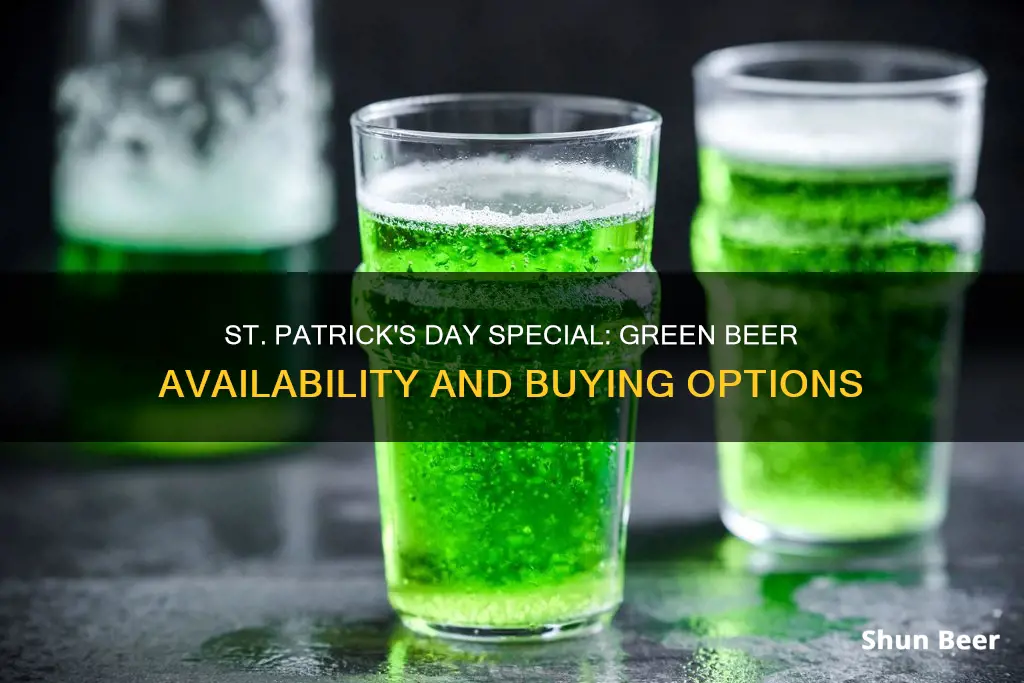
Green beer is a novelty drink that has become synonymous with St. Patrick's Day. The tradition of drinking green beer is purely American, with the Irish still sticking to Guinness or a shot of Irish whiskey. The drink is typically made by adding a few drops of green or blue food colouring to a light-coloured beer, although some opt for beers with green bottles or cans, such as Heineken or Stella Artois. For those who don't want to use artificial dyes, natural alternatives like wheatgrass, spirulina, spinach, or matcha can be used to achieve a green hue, although these options may alter the taste of the drink.
| Characteristics | Values |
|---|---|
| Occasion | St. Patrick's Day |
| Colour | Green |
| Availability | In bars, at home, or in beer bottles/cans |
| Dye | Food colouring, fabric dye, wheatgrass, spirulina, matcha, or all-natural food dyes |
| Beer Type | Light-coloured beers, IPAs, pilsners, lagers, stouts, or hazy IPAs |
| Beer Brands | Budweiser, Miller, Busch, Coors, Heineken, Rolling Rock, Stella Artois, Genesee Cream Ale, Guinness, Harp, Budweiser, or Magners |
What You'll Learn

Where to buy green beer
Green beer is a novelty drink that has become synonymous with St. Patrick's Day. The tradition is said to have started in 1914 when an Irish-American physician, Dr. Thomas H. Curtain, added blue dye to beer for his New York clubhouse. The drink has since become a mainstream symbol of the Irish holiday, although it is not an Irish tradition.
If you want to get your hands on some green beer to celebrate St. Patrick's Day, here are some options:
Local Bars and Pubs
The most reliable way to get green beer is to check your local bars and pubs. Many establishments will serve green beer to celebrate St. Patrick's Day. For example, if you're in South Florida, spots like Waxy's Irish Pub in Fort Lauderdale, O'Shea's Irish Pub in West Palm Beach, and Finnegan's Way in Miami are known to serve green beer. The Tilted Kilt restaurant chain also features an Irish Hooley menu for the entire month of March, which includes green beer. Check with your local bars to see if they'll be offering green beer, or keep an eye on their social media accounts for updates.
Make Your Own Green Beer
If you can't find green beer at your local bars, you can easily make your own at home. All you need is your favourite light-coloured beer (IPAs, pilsners, and light lagers work best) and green or blue food colouring. Simply add a couple of drops of food colouring to your beer, and you're good to go! You can also add the food colouring first to the glass and then pour in the beer to watch the colour change as it mixes.
Beers with Green Bottles or Cans
If you don't have access to green food colouring or prefer not to add it to your beer, you can opt for beers with green bottles or cans. Heineken, Rolling Rock, Stella Artois, and Genesee Cream Ale all have green-hued containers, which can still put you in the St. Patrick's Day spirit, even if the beer itself isn't green.
Craft Beers
If you're looking for a more sustainable and eco-friendly option, you might want to consider craft beers from breweries that are striving to minimise their environmental impact. While these beers might not be green in colour, they offer a "green" alternative in terms of their production methods. Some options include New Belgium 1554 Dark Lager, Sierra Nevada Pale Ale, Great Lakes Brewing Company Edmund Fitzgerald Porter, and Brooklyn Brewery Dry Irish Stout.
Buy Beer Wholesale: A Guide to Bulk Beer Buying
You may want to see also

How to make green beer
Green beer is a novelty drink that has become synonymous with St. Patrick's Day. It is said that the tradition of drinking green beer was started by an Irish-American physician, Dr. Thomas H. Curtain, in 1914. He added blue dye to the beer for a St. Patrick's Day party at his New York clubhouse, and the rest is history!
If you want to make green beer at home, it's quite simple. All you need is a light-coloured beer and some food colouring. The lighter the beer, the brighter the green will be. So, American lagers, pilsners, pale-coloured craft beers, and German pilsners are good options. Avoid stouts and other dark beers as they will not show the green colour very well.
When it comes to food colouring, you can use either green or blue. If you use blue food colouring, it will mix with the natural yellow colour of the beer to create a bright green shade. Add a couple of drops at a time until you get the desired colour. It's best to use liquid food colouring as gel may not mix well with cold beer.
Pour the beer into a glass, add the food colouring, and stir to mix. And that's it! You now have a festive green beer to enjoy on St. Patrick's Day or any other occasion.
The Best Places to Buy Ultra-Right Beer
You may want to see also

Green beer and St. Patrick's Day
Green beer is a St. Patrick's Day tradition that involves drinking beer that has been dyed green. While it is often associated with Ireland, the tradition is more popular in the US and actually originated in New York City in 1914. It is said that the tradition was started by a physician named Dr Thomas H. Curtain, who added blue or green fabric dye to beer at his New York clubhouse. The drink became a hit and soon became a symbol of the Irish holiday, despite not being an Irish tradition.
Over time, green beer has become a staple of St. Patrick's Day celebrations, especially in the United States. Many bars and pubs serve green beer during the holiday, and it can also be easily made at home. To make green beer, one simply needs to add a few drops of green or blue food colouring to a light-coloured beer. The lighter colour of the beer allows the green hue to shine through, creating a bright and festive drink. While any beer can be used, lighter beers like lagers, pilsners, and IPAs are typically recommended for the best colour.
For those who want to avoid artificial dyes, there are natural alternatives to achieve a green hue. Wheatgrass, spinach, spirulina, or matcha can be used to give the beer a green tint while also adding a slight flavour to the drink. These natural options may not produce as vibrant a colour as artificial dyes, but they offer a healthier and more flavourful alternative.
In recent years, some breweries have also experimented with creating green beer without the use of traditional dyes. For example, Dogfish Head Brewery in Delaware used spirulina, a type of blue-green algae, to give their German lager a green sheen. While these attempts have not become mainstream, they offer an interesting twist on the traditional green beer.
Whether purchased at a bar or made at home, green beer is a fun and festive way to celebrate St. Patrick's Day. It adds a unique twist to the traditional pint of beer and is a simple way to get into the spirit of the Irish holiday. So, if you're looking for a way to make your St. Patrick's Day celebration a little more colourful, green beer is definitely the way to go!
Narragansett Beer: Where to Buy and Enjoy It
You may want to see also

Green beer in Ireland
Green beer is not traditionally Irish, despite being associated with St. Patrick's Day. The tradition of drinking green beer is thought to have originated in the United States, created by an Irish-American physician named Thomas H. Curtain in 1914. Curtain added blue dye to beer, which mixed with the natural yellow colour of the beer to create a green hue. The drink was first served at Curtain's New York clubhouse and soon became a symbol of St. Patrick's Day, despite not being an Irish tradition.
In fact, it was as late as 1985 that the people of Ireland were still being introduced to green beer, according to United Press International. While the Irish have a tradition of dropping clovers in drinks for good luck, known as "downing the shamrock", turning beer bright green is purely an American move.
If you're set on drinking green beer, you can either find a local bar that serves it or make it yourself at home. To make green beer, simply add a couple of drops of blue or green food colouring to a light-coloured beer. Beers such as Budweiser, Miller, Busch, or Coors are recommended for the best colour. However, if you're looking to drink like a real Irishman, nothing beats a pint of Guinness or a shot of Irish whiskey.
So, while green beer may be a fun novelty for St. Patrick's Day celebrations, it is not a traditional Irish drink.
Buying Beer on Easter Sunday: Texas Laws Explained
You may want to see also

Green beer alternatives
Green beer is a novelty drink often consumed on St. Patrick's Day. The drink is typically made by adding green or blue food colouring to light-coloured beers. However, if you are looking for alternatives to green beer, there are several options to consider.
Firstly, you could opt for beers with green bottles or cans, such as Heineken, Rolling Rock, Stella Artois, or Genesee Cream Ale. While the beer itself will not be green, drinking from a green container can still evoke the spirit of St. Patrick's Day.
If you are looking for alternatives to green beer that are more in line with traditional Irish beverages, consider a pint of Guinness or a shot of Irish whiskey. Irish stout, such as O'Hara's or Breck's Nitro Irish Stout, is another option, offering a creamy mouthfeel and flavours of dark chocolate and coffee. Irish red ales, such as Smithwick's or Boulevard's early spring seasonal brew, are also great choices, known for their rich, toasty flavours and reddish-copper hues.
For those who want a non-alcoholic alternative, there are a few options that can provide a similar taste and mouthfeel to beer. Hop tea, made by infusing water with hops, can be a good substitute, especially when paired with herbal or hop-based bitters. Kombucha, a fermented drink, can also have flavours similar to beer, particularly sour or funky-style beers. Additionally, cold brew coffee, especially when served on nitro, can offer a roasty flavour and bitterness reminiscent of beer, without the alcohol or calories.
So, while green beer may be a fun and festive choice for St. Patrick's Day, there are plenty of other options to consider that offer a more authentic Irish drinking experience or provide similar sensory experiences without the green hue.
Buying Beer in Connecticut: Grocery Store Rules Explained
You may want to see also
Frequently asked questions
Green beer is usually available at local bars and pubs during St. Patrick's Day. You can also make your own at home by adding a few drops of green or blue food colouring to a light-coloured beer.
No, green beer is not an Irish tradition. It is usually credited to an Irish-American physician, Thomas H. Curtain, who created it in 1914 by adding blue dye to beer for his New York clubhouse.
Any light-coloured beer will work when making green beer. Popular American lagers like Budweiser, Miller, Busch, or Coors are good options.
Yes, you can use natural alternatives such as wheatgrass, spirulina, spinach, matcha, or all-natural food dyes. However, these options may alter the taste of your drink and may not produce as vibrant a colour.
Yes, if you want to celebrate St. Patrick's Day with a drink, a pint of Guinness or a shot of Irish whiskey are more traditional options.







